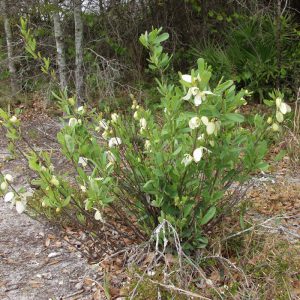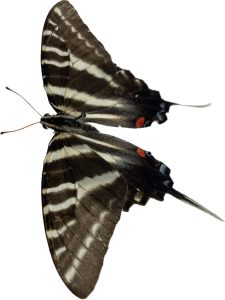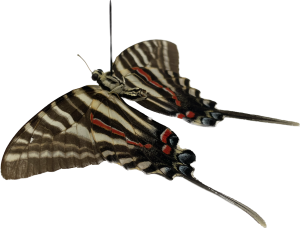
Pollinators are of extreme importance to our Florida Flatwoods ecosystem. They are responsible for transferring genes of plants from one flower to another increasing fruit set in wild and domesticated species. By doing so, these organisms help plants adapt to changes in the environment, combat diseases, and increase hardiness in a natural way. Butterflies are one of the most highly regarded pollinators in our backyards, natural areas, and farms. Of these, one of my favorite species is Eurytides marcellus, also known as Zebra swallowtail.
The Zebra swallowtail butterfly is one of over 170 species of butterflies that call Florida home (if they could talk). This state hosts 25 swallowtail butterfly species in total. This butterfly is a fairly common, but beautiful species native to our area. With its striking black and white striped wings and bright red spots, it is a sight to behold. Its characteristic long “wing tails”, correctly defined as apex, it is hard to miss this big butterfly gliding by in an open field.
The life cycle of a swallowtail

The Zebra Swallowtail butterfly has a four–stage lifecycle, beginning with an egg that is laid on the underside of pawpaw leaf (most commonly found in netted and willow pawpaw in this area of the State; Asimina spp.) but there are various species in Florida. The egg will then hatch into a caterpillar, which can range in coloration from mostly green with black, white, and yellow stripes to mostly black with no green, white and yellow. The caterpillar will feed on the leaves of the pawpaw tree and will eventually form a chrysalis. This chrysalis often resembles a green leaf and hangs from the pawpaw main stem or branches.

After two weeks, the chrysalis will hatch into the adult butterfly, which is black and white with bright red spots. The adult butterfly will feed on nectar from plants such as thistles, asters, and milkweed. After mating, the female will lay eggs on the underside of pawpaw leaves and the cycle will start again.
Unfortunately, its population is in danger of becoming extinct due to the destruction of its host plant.
How can we protect this beauty?
These butterflies need a healthy population of their host plant for survival. In overgrazed pastures the population of pawpaw plants has been significantly reduced. This has had a drastic effect on the Zebra Swallowtail population, as they have fewer places to feed and reproduce. Areas where invasive species like Cogongrass (Imperata cylindrica) take hold reduce the prevalence of the host plant. This has caused the pawpaws to be shaded out, resulting in fewer places for the butterflies to feed and reproduce.

The Zebra Swallowtail butterfly is a species in need of protection. With the proper management of pasturelands, such as appropriate limiting, use of fertilizers based on soil analysis, and the adequate stocking rate of cattle and other livestock, the pawpaw plants will be able to thrive, allowing the Zebra Swallowtail population to increase, and ensure that this beautiful species will not become a rarity in Hardee County.
Invasive plant management is a key effort in preserving and protecting native species such as the Zebra swallowtail. This can be done by using herbicides to remove the plants, planting improved pasture grasses, and cross fencing our pastures. We can also help this species by creating habitat corridors or small areas of habitat that host paw paws, and other native plants that the species uses for feeding and breeding. Homeowners can also promote the growth of the pawpaw tree by planting seedlings in areas of their yards and enjoy the fragrant flowers and rare fruits while they observe this butterfly and its young.

Moving forward

Preserving iconic species such as the Zebra swallowtail butterfly is important for Florida farmers and ranchers. The adoption of science-based practices in our farming and ranching operations can help us ensure that this species thrives and that our children can marvel at their grace and beauty. Homeowners can also do their part by hosting these creatures in our backyards and gardens. By increasing our understanding of pollinators and their importance we are better equipped to protect and conserve these and other species of native butterflies and pollinators for future generations. If you would like more information on this topic, please contact the UF/IFAS Extension Hardee County at (863) 773-2164, or drop by at 507 Civic Center Drive, Wauchula FL 33873.
References and further reading
- Featured Creatures – zebra swallowtail (ufl.edu)
- ZEBRA SWALLOWTAIL PROTOGRAPHIUM MARCELLUS – EENY-58/IN215: Zebra Swallowtail Protographium marcellus (Cramer) (Insecta: Lepidoptera: Papilionidae) (ufl.edu)
- Florida Native Plant Society (FNPS)
- BAHIAGRASS (PASPALUM NOTATUM FLUEGGÉ): OVERVIEW AND PASTURE MANAGEMENT – SS-AGR-332/AG342: Bahiagrass (Paspalum notatum Flueggé): Overview and Pasture Management (ufl.edu)
 1
1
